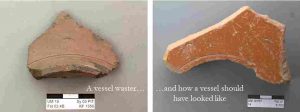
Dear Colleagues,
We happily inform you on an intensive survey at Çandarlı (ancient Pitane) where in 1911 Siegfried Loeschcke (Athenische-Mitteilungen 1912__p0360-0423) discovered evidence of what turned out to be the very first archaeologically attested production centre of terra sigillata in the Eastern Mediterranean. The Pitane Survey (2019-2020) is part of the larger regional TransPergMikro project (https://www.dainst.blog/transpergmikro/about-the-project/), which is funded by the German Science Foundation and directed by the Istanbul branch of the German Archaeological Institute, the Free University in Berlin, the Technical University in Berlin, the Celal Bayar University in Manisa, and the Christian-Albrechts-University in Kiel.
The aims of the Pitane Survey are to (1) document in detail the typological and macroscopic fabric repertoire of the local manufacture, which comprises Eastern Sigillata C and Late Roman C, supported by archaeometrical analyses; (2) reconstruct (parts of) the chaîne opératoire by studying, for example, vessel wasters as well as artefacts used in manufacture and firing; and (3) better understand the socio-economic context in which the pottery manufacture was organised by looking at non-manufacture related artefacts, landscape and the distribution of ESC and LRC vessels that were manufactured at Pitane. For 2021 our purpose is to complete aims 1 and 2 and prepare data and observations for final publication which is scheduled for (early) 2022.
Please take a look at our two contributions on the TransPergMikro blog for more details:
https://www.dainst.blog/transpergmikro/pitane-survey-2019/
https://www.dainst.blog/transpergmikro/pitane-survey-2020/
If you have questions or wish to respond (we welcome both!), please feel free to contact Philip Bes (philipmbes@gmail.com) and Anneke Keweloh-Kaletta (anneke.keweloh@web.de).


Hello Philip,
congratulations for your very interesting survey. Can you say, where at Çandarlı are or should have been the workshop(s) of this Sigillata production center and the relation to your survey fields?
Dear Fridolin,
Thank you for your kind response.
This is a relevant question of course, and something we are looking into. Most of the fields (so not all, which is also intriguing!) we have surveyed are scattered with different kinds of production waste: vessel wasters, spacer discs, kiln slag, etc. These fields have been researched with geophysical methods, which show only one anomaly that might be the remains of a (ceramic?) kiln.
Within the team we are currently working with several hypotheses and ideas, but because we have only studied part of the collected artefacts it is clear that to try and answer also this question we will have to complete the study and mapping of the remaining finds, something that can hopefully take place later this year! Still, the artefacts already provide us with a fascinating look into terra sigillata manufacture at the site.
With my best wishes,
Philip
Hello Philip,
Geomagnetic prospection: I made it in my excavation in Rheinzabern before excavating. The kilns are visible very well. Normal things have readings like 20-30, but the kilns around 400. In the field of 1981 (see below) all kilns were for tile production.
Cf. Rheinzabern 1981. Geomagnetic prospection and excavation plans.
(Germania 61,1983,35 Abb.2. 36 Abb.3. 45 Abb.7. Beilage 4)